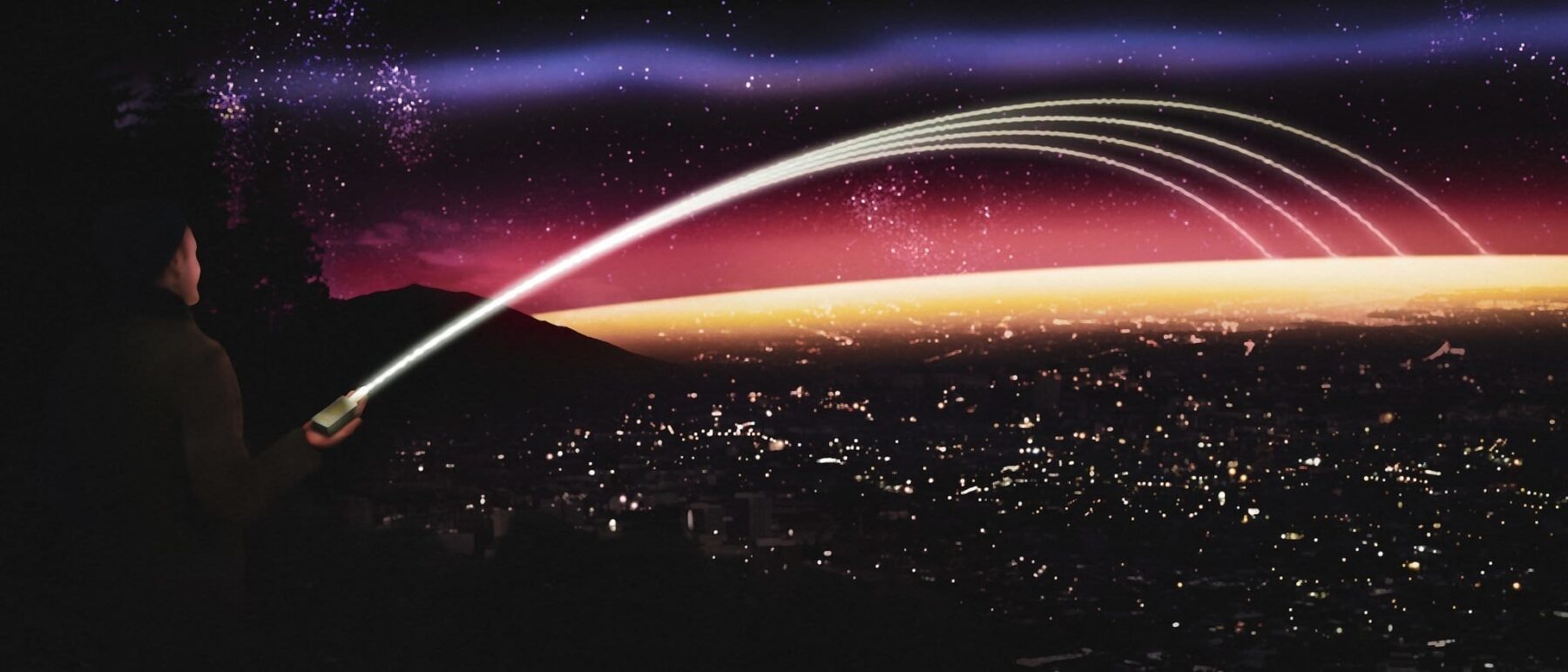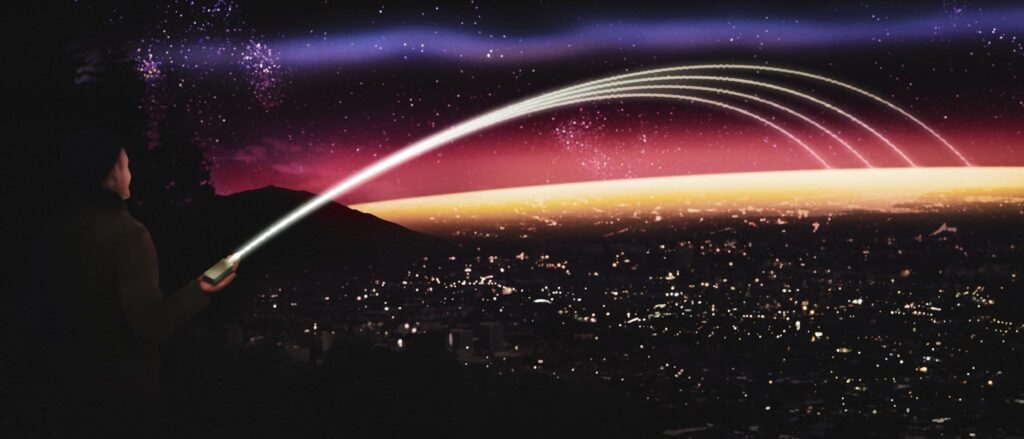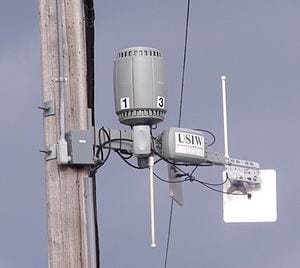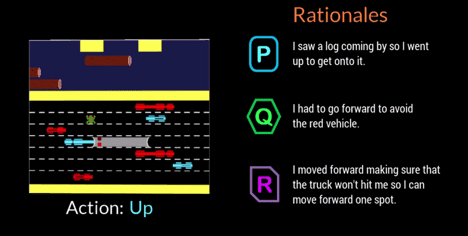A new type of pocket-sized antenna, developed at the Department of Energy’s SLAC National Accelerator Laboratory, could enable mobile communication in situations where conventional radios don’t work, such as under water, through the ground and over very long distances through air.
The device emits very low frequency (VLF) radiation with wavelengths of tens to hundreds of miles. These waves travel long distances beyond the horizon and can penetrate environments that would block radio waves with shorter wavelengths. While today’s most powerful VLF technology requires gigantic emitters, this antenna is only four inches tall, so it could potentially be used for tasks that demand high mobility, including rescue and defense missions.
“Our device is also hundreds of times more efficient and can transmit data faster than previous devices of comparable size,” said SLAC’s Mark Kemp, the project’s principal investigator. “Its performance pushes the limits of what’s technologically possible and puts portable VLF applications, like sending short text messages in challenging situations, within reach.”
The SLAC-led team reported their results today in Nature Communications.
A sizable challenge
In modern telecommunications, radio waves transport information through air for radio broadcasts, radar and navigation systems and other applications. But shorter-wavelength radio waves have their limits: The signal they transmit becomes weak over very long distances, can’t travel through water and is easily blocked by layers of rock.
In contrast, the longer wavelength of VLF radiation allows it to travel hundreds of feet through ground and water and thousands of miles beyond the horizon through air.
However, VLF technology also comes with major challenges. An antenna is most efficient when its size is comparable to the wavelength it emits; VLF’s long wavelength requires enormous antenna arrays that stretch for miles. Smaller VLF transmitters are much less efficient and can weigh hundreds of pounds, limiting their intended use as mobile devices. Another challenge is the low bandwidth of VLF communication, which limits the amount of data it can transmit.
The new antenna was designed with these issues in mind. Its compact size could make it possible to build transmitters that weigh only a few pounds. In tests that sent signals from the transmitter to a receiver 100 feet away, the researchers demonstrated that their device produced VLF radiation 300 times more efficiently than previous compact antennas and transmitted data with almost 100 times greater bandwidth.
“There are many exciting potential applications for the technology,” Kemp said. “Our device is optimized for long-range communication through air, and our research is looking at the fundamental science behind the method to find ways to further enhance its capabilities.”
A mechanical antenna
To generate VLF radiation, the device exploits what is known as the piezoelectric effect, which converts mechanical stress to a buildup of electrical charge.
The researchers used a rod-shaped crystal of a piezoelectric material, lithium niobate, as their antenna. When they applied an oscillating electric voltage to the rod it vibrated, alternately shrinking and expanding, and this mechanical stress triggered an oscillating electric current whose electromagnetic energy then got emitted as VLF radiation.
The electric current stems from electric charges moving up and down the rod. In conventional antennas, these motions are close to the same size as the wavelength of the radiation they produce, and more compact designs typically require tuning units that are larger than the antenna itself. The new approach, on the other hand, “allows us to efficiently excite electromagnetic waves with wavelengths that are much larger than the motions along the crystal and without large tuners, which is why this antenna is so compact,” Kemp said.
The researchers also found a clever way of tweaking the wavelength of the emitted radiation, he said: “We repeatedly switch the wavelength during operation, which allows us to transmit with a large bandwidth. This is key to achieving data transfer rates of more than 100 bits per second – enough to send a simple text.”
Learn and see more: SLAC develops novel compact antenna for communicating where radios fail
The Latest on: VLF radiation
[google_news title=”” keyword=”VLF radiation” num_posts=”10″ blurb_length=”0″ show_thumb=”left”]
via Google News
The Latest on: VLF radiation
- Decametric Radio Emissions of Jupiteron April 19, 2024 at 4:59 pm
There are sufficient experimental results available to support strongly this hypothesis of the very-low-frequency radiation and hence by implication the validity of the cyclotron process in an ...
- How super resilient tardigrades can fix their radiation-damaged DNAon April 16, 2024 at 11:10 am
Tardigrades can even withstand dangerous levels of radiation and a surprising mechanism in the DNA may be why. The process to repair DNA goes into overtime when exposed to the deadly radiation to ...
- Studies reveal new clues to how tardigrades can survive intense radiationon April 16, 2024 at 6:55 am
Since the 1960s, scientists have known that the tiny tardigrade can withstand very intense radiation blasts 1,000 times stronger than what most other animals could endure. According to a new paper ...
- NASA breaks down eclipse radiation mythson April 8, 2024 at 10:45 am
As millions of spectators across the U.S. gathered to watch Monday's total solar eclipse, some were concerned over radiation, but NASA has debunked myths around the eclipse. The moon crosses in ...
- Navy's new VLF Radar Station project in Telangana of national importance, safe for people near site: Sourceson April 8, 2024 at 4:04 am
Reddy expressed apprehension that the radiation emitted from the radar ... an overall ecological balance in the area. The Very Low Frequency (VLF) transmitters operate in a radio frequency band ...
- Mysterious 'radiation leak' sparks Russia nationwide state of emergency over nuclear riskon April 5, 2024 at 8:45 am
The Russian authorities have not explained what is causing the alarming radiation in Khabarovsk. A mystery radiation source was today “removed and placed in a protective container” and ...
- Online training in radiation protectionon March 2, 2024 at 5:02 pm
These e-learning courses assist professionals from Member States in building capacity in the field of radiation protection of patients. Most of them offer a certification of attendance. To access the ...
- The effects of radiation on the human bodyon January 8, 2024 at 2:09 am
Some of the effects that radiation has on a human body are shown below. Eyes High doses can cause cataracts. Thyroid Radioactive iodine can build up and cause cancer, particularly during growth.
- Radio Frequency Safetyon August 4, 2023 at 12:48 pm
The Radio-Frequency (RF) Safety Program is managed by the Radiation Safety Office; a subset of the Office of Environmental and Emergency Management (EEM). We are here to ensure that RF use on campus ...
- Radiation Safety Officeon August 4, 2023 at 12:47 pm
The Radiation Safety Office, part of the Environmental Health and Safety Department and managed by the Director of Radiation Safety, maintains a staff adequate to assure the safe receipt, use, storage ...
via Bing News












